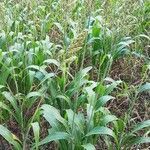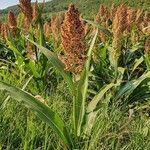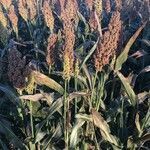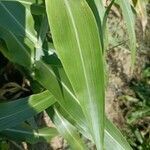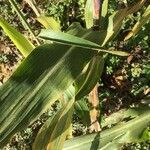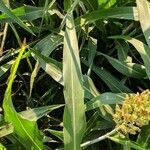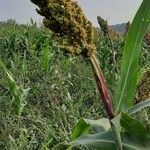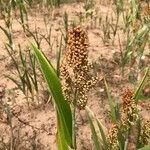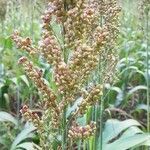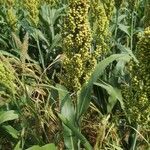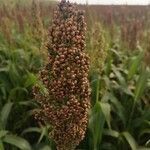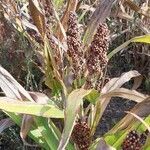A millet grass. A mature sorghum plant resembles maize. Plants vary in height from 45 cm to 4 m. It is an annual grass with erect solid stems. The stems can be 3 cm across at the base. Under the ground there is a widely branching extensive root system. Prop roots occur near the base. There are a range of different types of sorghum. Some have one main stem while others have many tillers. There are more tillers when plants are widely spaced. The nodes on the stem are slightly thickened. The distance between nodes is shortest near the base of the plant. Short eagerly kinds have 7 leaves while tall late varieties may have 24 leaves. The leaf blade can be 30-135 cm long. Leaves are bluish green and waxy. They have a prominent midrib. The large flower panicle can be 20-40 cm long. The flower occurs at the top of the plant. It can stick upright or bend over. The flower can be open or compact. There are several different varieties. Over 1000 cultivated varieties occur in China.
Annual. Culms erect, robust, 3–5 m tall, 2–5 cm in diam.; nodes glabrous or pubescent. Leaf sheaths glabrous or slightly farinose; leaf blades linear or linear-lanceolate, 40–70 × 3–8 cm, glabrous; ligule subrounded, ciliate. Panicle very variable, lax or dense, cylindrical or pyramidal to obovate in outline, up to 60 cm, main axis elongate to very short; primary branches ascending or spreading, lower branches sometimes almost as long as panicle, stiff or pendulous; racemes tough at maturity, composed of 2–6 spikelet pairs. Sessile spikelet variable, broadly obovate to subglobose, 3.5–5.5 mm; callus hispid; lower glume leathery to papery, glabrous to pilose, pale creamy-green to dark brown or blackish at maturity, upper lemma usually awned; awn 0.4–1.5 cm. Pedicelled spikelet male or barren, linear-lanceolate, persistent or deciduous. Caryopsis large, often exposed between the gaping glumes. Fl. and fr. Jun–Sep. 2n = 20.
Short-lived perennial or annual, up to 3 m high; rhizomes absent. Leaf blade 8-30 mm wide; ligule a fringed membrane. Inflorescence an open or contracted panicle; racemes readily to tardily disarticulating; internodes and pedicels filiform; spikelets in pairs, terminally in triplets, one sessile, the other pedicelled; pedicels free from rachis. Sessile spikelet 5-7 mm long, lanceolate-elliptic, dorsiventrally compressed, variously coloured at maturity; glumes ± equal, dissimilar; lower glume densely to loosely hairy, at maturity glossy, often almost glabrous. Florets 2; lower floret sterile, upper floret bisexual; lemma less firm than glumes, not indurated, awn 10-16(18) mm long, geniculate, partly twisted below; anther 2.0-4.0 mm long. Pedicelled spikelet 5-7 mm long, linear to lanceolate, awnless, deciduous, pale greenish yellow or often reddish to purplish. Flowering time Jan.-June.
Coarse, maize-like annual with broad lvs mostly (2–)3–5 cm wide; panicle 1.5–5 dm, its main axis usually ± hairy; pedicellate spikelet mostly shorter than the sessile one, which is spread open by the very turgid grain at maturity; 2n=20. Originally African, now widely cult. in numerous and diverse cultivars. Three interfertile vars. are recognized. Cult. plants with large grains and usually dense, non-disarticulating inflorescences are var. bicolor. Weedy and tall shattercanes and Sudan-grass are var. drummondii (Nees) Mohlenbr. They often occur in sorghum-fields, mature early, and have fragile racemes that readily fragment. The native wild African plants, which form a third var., are ancestors of the cultivars.
Tufted annual or short-lived perennial, up to 3 m tall. Leaves broad, flat; ligule a fringed membrane. Inflorescence a panicle 600 mm long with spreading branches. Spikelets many, dissimilar, these paired in a sessile-pedicelled combination. Sessile spikelets 5-7 mm long, 2-flowered, usually short hairy; awn up to 20 mm long or rarely awnless. Year-round but mainly Dec.-Mar.
